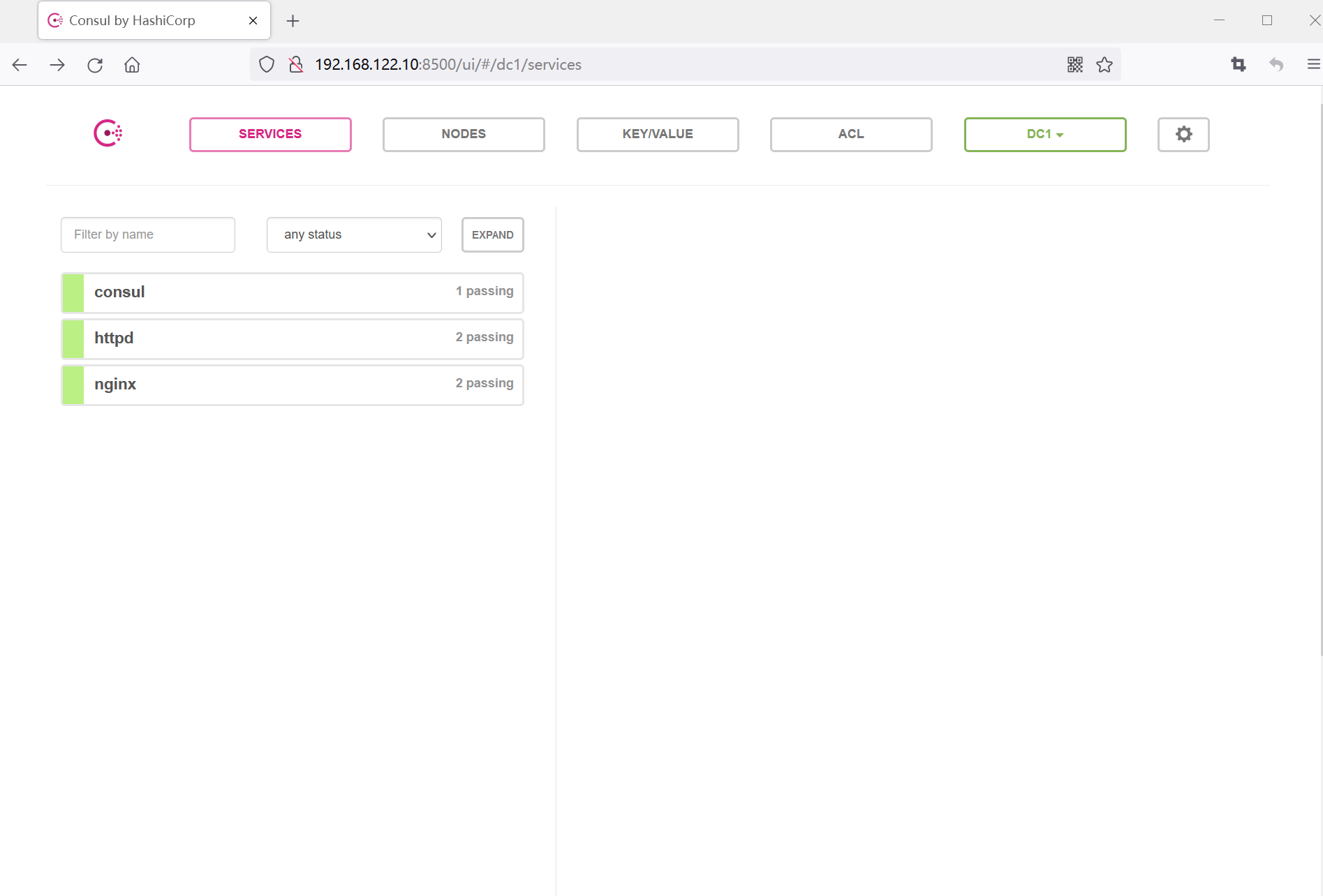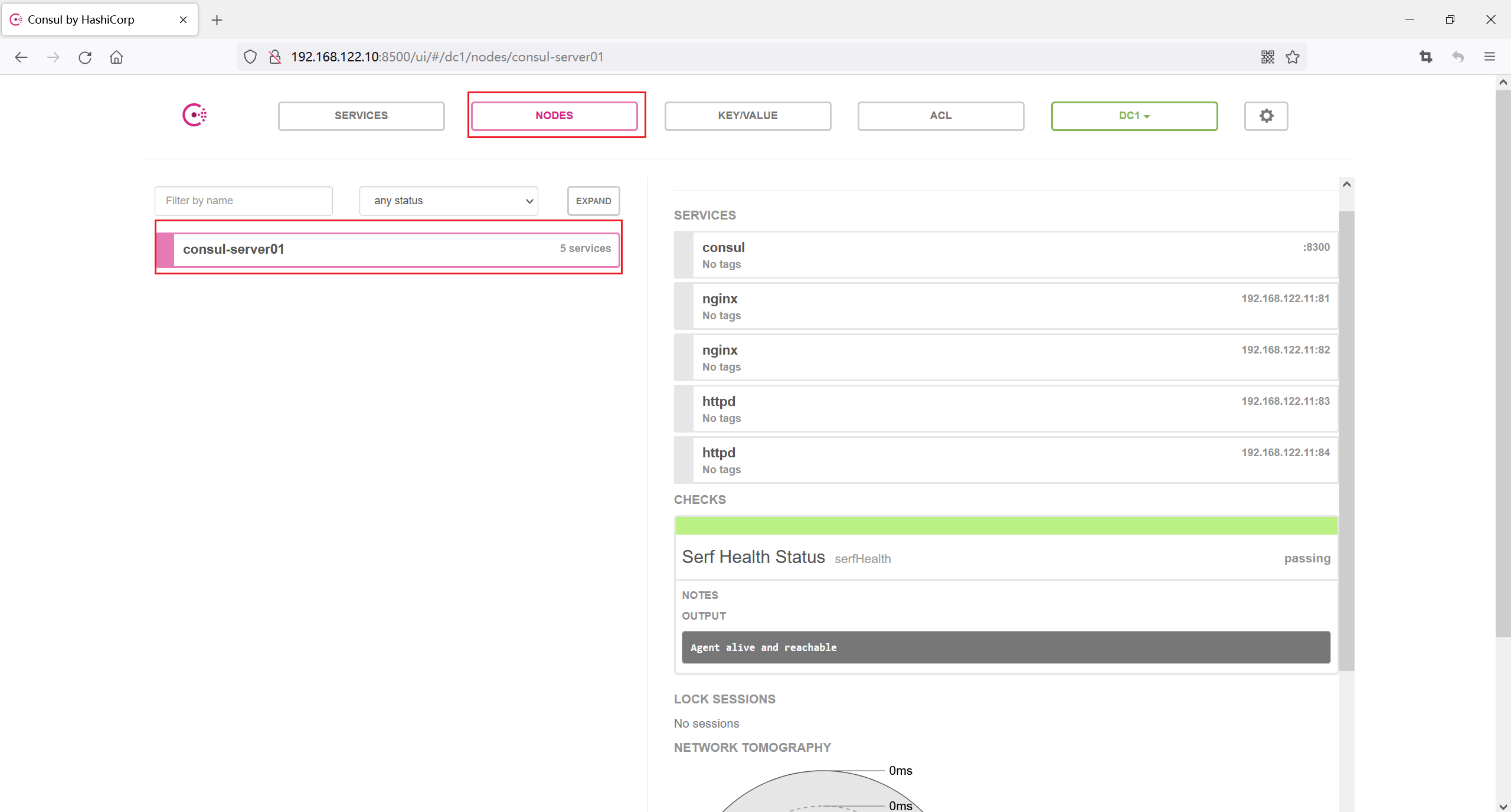Docker consul
Docker consul的容器服务更新与发现
一、Consul简介
1. 服务注册与发现
服务注册与发现是微服务架构中不可或缺的重要组件。起初服务都是单节点的,不保障高可用性,也不考虑服务的压力承载,服务之间调用单纯的通过接口访问。直到后来出现了多个节点的分布式架构,起初的解决手段是在服务前端负载均衡,这样前端必须要知道所有后端服务的网络位置,并配置在配置文件中。这里就会有几个问题:
● 如果需要调用后端服务A-N,就需要配置N个服务的网络位置,配置很麻烦
● 后端服务的网络位置变化,都需要改变每个调用者的配置
既然有这些问题,那么服务注册与发现就是解决这些问题的。后端服务A-N可以把当前自己的网络位置注册到服务发现模块,服务发现就以K-V的方式记录下来,K一般是服务名,V就是IP:PORT。服务发现模块定时的进行健康检查,轮询查看这些后端服务能不能访问的了。前端在调用后端服务A-N的时候,就跑去服务发现模块问下它们的网络位置,然后再调用它们的服务。这样的方式就可以解决上面的问题了,前端完全不需要记录这些后端服务的网络位置,前端和后端完全解耦!
2. consul概述
consul是google开源的一个使用go语言开发的服务管理软件。支持多数据中心、分布式高可用的、服务发现和配置共享。采用Raft算法,用来保证服务的高可用。内置了服务注册与发现框架、分布一致性协议实现、健康检查、Key/Value存储、多数据中心方案,不再需要依赖其他工具(比如ZooKeeper等)。服务部署简单,只有一个可运行的二进制的包。每个节点都需要运行agent,他有两种运行模式server 和 client。 每个数据中心官方建议需要3或5个server节点以保证数据安全,同时保证server-leader的选举能够正确的进行。
安装consul是用于服务注册,也就是容器本身的一些信息注册到consul里面,其他程序可以通过consul获取注册的相关服务信息,这就是服务注册与发现。
3. consul的两种模式
在client模式下,所有注册到当前节点的服务会被转发到server节点,本身是不持久化这些信息。
在server模式下,功能和client模式相似,唯一不同的是,它会把所有的信息持久化到本地,这样遇到故障,信息是可以被保留的。
server-leader是所有server节点的老大,它和其它server节点不同的是,它需要负责同步注册的信息给其它的server节点,同时也要负责各个节点的健康监测。
4. consul提供的一些关键特性
● 服务注册与发现:consul通过DNS或者HTTP接口使服务注册和服务发现变的很容易,一些外部服务,例如saas提供的也可以一样注册。
● 健康检查:健康检测使consul可以快速的告警在集群中的操作。和服务发现的集成,可以防止服务转发到故障的服务上面。
● Key/Value存储:一个用来存储动态配置的系统。提供简单的HTTP接口,可以在任何地方操作。
● 多数据中心:无需复杂的配置,即可支持任意数量的区域。
二、consul部署
1. 服务器配置
| 服务器 | IP地址 | 主机名 | 主要功能 |
|---|---|---|---|
| consul服务器 | 192.168.122.10 | consul | 运行consul服务、nginx服务、consul-template守护进程 |
| registrator服务器 | 192.168.122.11 | registrator | 运行registrator容器、运行nginx容器 |
systemctl disable --now firewalld.service
setenforce 0
2. consul服务器
2.1 建立consul服务
[root@consul ~]# mkdir /opt/consul
[root@consul ~]# cd /opt/consul
[root@consul consul]# rz -E
#传入安装包consul_0.9.2_linux_amd64.zip
rz waiting to receive.
[root@consul consul]# unzip consul_0.9.2_linux_amd64.zip
[root@consul consul]# mv consul /usr/local/bin/
设置代理,在后台启动consul服务端
[root@consul consul]# consul agent \
> -server \
> -bootstrap \
> -ui \
> -data-dir=/var/lib/consul-data \
> -bind=192.168.122.10 \
> -client=0.0.0.0 \
> -node=consul-server01 &> /var/log/consul.log &
[1] 30191
-server: 以server身份启动。默认是client。
-bootstrap :用来控制一个server是否在bootstrap模式,在一个数据中心中只能有一个server处于bootstrap模式,当一个server处于 bootstrap模式时,可以自己选举为 server-leader。
-bootstrap-expect=2 :集群要求的最少server数量,当低于这个数量,集群即失效。
-ui :指定开启 UI 界面,这样可以通过 http://localhost:8500/ui 这样的地址访问 consul 自带的 web UI 界面。
-data-dir :指定数据存储目录。
-bind :指定用来在集群内部的通讯地址,集群内的所有节点到此地址都必须是可达的,默认是0.0.0.0。
-client :指定 consul 绑定在哪个 client 地址上,这个地址提供 HTTP、DNS、RPC 等服务,默认是 127.0.0.1。
-node :节点在集群中的名称,在一个集群中必须是唯一的,默认是该节点的主机名。
-datacenter :指定数据中心名称,默认是dc1。
[root@consul consul]# netstat -natp | grep consul
tcp 0 0 192.168.122.10:8300 0.0.0.0:* LISTEN 30191/consul
tcp 0 0 192.168.122.10:8301 0.0.0.0:* LISTEN 30191/consul
tcp 0 0 192.168.122.10:8302 0.0.0.0:* LISTEN 30191/consul
tcp6 0 0 :::8500 :::* LISTEN 30191/consul
tcp6 0 0 :::8600 :::* LISTEN 30191/consul
启动consul后默认会监听5个端口:
8300:replication、leader farwarding的端口
8301:lan cossip的端口
8302:wan gossip的端口
8500:web ui界面的端口
8600:使用dns协议查看节点信息的端口
2.2 查看群集信息
查看members状态
[root@consul consul]# consul members
Node Address Status Type Build Protocol DC
consul-server01 192.168.122.10:8301 alive server 0.9.2 2 dc1
查看群集状态
[root@consul consul]# consul operator raft list-peers
Node ID Address State Voter RaftProtocol
consul-server01 192.168.122.10:8300 192.168.122.10:8300 leader true 2
2.3 通过http api获取群集信息
[root@consul consul]# curl 127.0.0.1:8500/v1/status/peers
["192.168.122.10:8300"][root@consul consul]#
[root@consul consul]# curl 127.0.0.1:8500/v1/status/leader
"192.168.122.10:8300"[root@consul consul]#
[root@consul consul]# curl 127.0.0.1:8500/v1/catalog/services
{"consul":[]}[root@consul consul]#
[root@consul consul]# curl 127.0.0.1:8500/v1/catalog/nginx
[root@consul consul]# curl 127.0.0.1:8500/v1/catalog/nodes
[{"ID":"d96ffa01-9116-368b-1b88-407cf7efbda7","Node":"consul-server01","Address":"192.168.122.10","Datacenter":"dc1","TaggedAddresses":{"lan":"192.168.122.10","wan":"192.168.122.10"},"Meta":{},"CreateIndex":5,"ModifyIndex":6}][root@consul consul]#
curl 127.0.0.1:8500/v1/status/peers #查看集群server成员
curl 127.0.0.1:8500/v1/status/leader #集群 server-leader
curl 127.0.0.1:8500/v1/catalog/services #注册的所有服务
curl 127.0.0.1:8500/v1/catalog/nginx #查看 nginx 服务信息
curl 127.0.0.1:8500/v1/catalog/nodes #集群节点详细信息
3. registrator服务器
容器服务自动加入nginx群集
3.1 安装Gliderlabs/Registrator
Gliderlabs/Registrator可检查容器运行状态自动注册,还可注销docker容器的服务到服务配置中心。目前支持Consul、Etcd和SkyDNS2。
[root@registrator ~]# docker run -d \
> --name=registrator \
> --net=host \
> -v /var/run/docker.sock:/tmp/docker.sock \
> --restart=always \
> gliderlabs/registrator:latest \
> --ip=192.168.122.11 \
> consul://192.168.122.10:8500
[root@registrator ~]# docker images
REPOSITORY TAG IMAGE ID CREATED SIZE
gliderlabs/registrator latest 3b59190c6c80 5 years ago 23.8MB
[root@registrator ~]# docker ps -a
CONTAINER ID IMAGE COMMAND CREATED STATUS PORTS NAMES
70c4cab43710 gliderlabs/registrator:latest "/bin/registrator --…" 3 minutes ago Up 3 minutes registrator
--net=host :把运行的docker容器设定为host网络模式。
-v /var/run/docker.sock:/tmp/docker.sock :把宿主机的Docker守护进程(Docker daemon)默认监听的Unix域套接字挂载到容器中。
--restart=always :设置在容器退出时总是重启容器。
--ip :刚才把network指定了host模式,所以我们指定ip为宿主机的ip。
consul :指定consul服务器的IP和端口。
3.2 测试服务发现功能是否正常
[root@registrator ~]# docker run -itd -p 81:80 --name test1 nginx
8b2fd482499911ddf46825b2995235aab6d14fdbefe0ef6d8d884b307dad2074
[root@registrator ~]# docker run -itd -p 82:80 --name test2 nginx
a7d1a09c7e6dff84787d19b3e323204af4cc50801e243ea8aa98c1b0923473c0
[root@registrator ~]# docker run -itd -p 83:80 --name test3 httpd
1f808f536a548432347800da73f27767e77a660d5e8d53b6269257d9de50db64
[root@registrator ~]# docker run -itd -p 84:80 --name test4 httpd
7dcf36adb446b0e0d5fc3fe55e4a4ac719e3b92c13aecdb09826cb1841b6d4e8
[root@registrator ~]# docker ps -a
CONTAINER ID IMAGE COMMAND CREATED STATUS PORTS NAMES
7dcf36adb446 httpd "httpd-foreground" 8 seconds ago Up 8 seconds 0.0.0.0:84->80/tcp, :::84->80/tcp test4
1f808f536a54 httpd "httpd-foreground" 15 seconds ago Up 15 seconds 0.0.0.0:83->80/tcp, :::83->80/tcp test3
a7d1a09c7e6d nginx "/docker-entrypoint.…" 2 minutes ago Up 2 minutes 0.0.0.0:82->80/tcp, :::82->80/tcp test2
8b2fd4824999 nginx "/docker-entrypoint.…" 2 minutes ago Up 2 minutes 0.0.0.0:81->80/tcp, :::81->80/tcp test1
70c4cab43710 gliderlabs/registrator:latest "/bin/registrator --…" 17 minutes ago Up 17 minutes registrator
3.3 验证http和nginx服务是否注册到consul
浏览器中,输入http://192.168.122.10:8500,在Web页面中“单击NODES”,然后单击“consul-server01”,会出现5个服务。


在consul服务器使用curl测试连接服务器
[root@consul consul]# curl 127.0.0.1:8500/v1/catalog/services
{"consul":[],"httpd":[],"nginx":[]}[root@consul consul]#
三、consul-template
1. consul-template概述
Consul-Template是基于Consul的自动替换配置文件的应用。Consul-Template是一个守护进程,用于实时查询Consul集群信息,并更新文件系统上任意数量的指定模板,生成配置文件。更新完成以后,可以选择运行 shell 命令执行更新操作,重新加载 Nginx。
2. consul-template的作用
Consul-Template可以查询Consul中的服务目录、Key、Key-values 等。这种强大的抽象功能和查询语言模板可以使 Consul-Template 特别适合动态的创建配置文件。例如:创建Apache/Nginx Proxy Balancers 、 Haproxy Backends等。
3. 准备template nginx模板文件
在consul服务器上操作
[root@consul ~]# vim /opt/consul/nginx.ctmpl
#定义nginx upstream一个简单模板
upstream http_backend {
{{range service "nginx"}}
server {{.Address}}:{{.Port}};
{{end}}
}
#定义一个server,监听8000端口,反向代理到upstream
server {
listen 8000;
server_name localhost 192.168.122.10;
#修改日志路径
access_log /var/log/nginx/test.com-access.log;
index index.html index.php;
location / {
proxy_set_header HOST $host;
proxy_set_header X-Real-IP $remote_addr;
proxy_set_header Client-IP $remote_addr;
proxy_set_header X-Forwarded-For $proxy_add_x_forwarded_for;
proxy_pass http://http_backend;
}
}
4. 编译安装nginx
[root@consul ~]# yum -y install pcre-devel zlib-devel gcc gcc-c++ make
[root@consul ~]# useradd -M -s /sbin/nologin nginx
[root@consul ~]# cd /opt
[root@consul opt]# rz -E
rz waiting to receive.
#传入安装包nginx-1.12.0.tar.gz
[root@consul opt]# tar zxvf nginx-1.12.0.tar.gz -C /opt/
[root@consul opt]# cd /opt/nginx-1.12.0/
[root@consul nginx-1.12.0]# ./configure --prefix=/usr/local/nginx --user=nginx --group=nginx && make && make install
[root@consul nginx-1.12.0]# ln -s /usr/local/nginx/sbin/nginx /usr/local/sbin/
5. 配置并启动nginx
配置nginx
[root@consul nginx-1.12.0]# vim /usr/local/nginx/conf/nginx.conf
······
http {
include mime.types;
include vhost/*.conf;
#添加虚拟主机目录
default_type application/octet-stream;
······
创建虚拟主机
[root@consul nginx-1.12.0]# mkdir /usr/local/nginx/conf/vhost
创建日志文件目录
[root@consul nginx-1.12.0]# mkdir /var/log/nginx
启动nginx
[root@consul nginx-1.12.0]# nginx
[root@consul nginx-1.12.0]# netstat -natp | grep nginx
tcp 0 0 0.0.0.0:80 0.0.0.0:* LISTEN 33272/nginx: master
6. 编译安装、启动并配置template
[root@consul nginx-1.12.0]# cd /opt
[root@consul opt]# rz -E
#传入安装包consul-template_0.19.3_linux_amd64.zip
rz waiting to receive.
[root@consul opt]# unzip consul-template_0.19.3_linux_amd64.zip -d /opt/
[root@consul opt]# mv consul-template /usr/local/bin/
在前台启动 template 服务,启动后不要按 ctrl+c 中止 consul-template 进程
[root@consul opt]# consul-template --consul-addr 192.168.122.10:8500 \
> --template "/opt/consul/nginx.ctmpl:/usr/local/nginx/conf/vhost/test.conf:/usr/local/nginx/sbin/nginx -s reload" \
> --log-level=info
······
另外打开一个终端查看生成配置文件
[root@consul ~]# cd /usr/local/nginx/conf/vhost/
[root@consul vhost]# ls
test.conf
[root@consul vhost]# cat test.conf
#定义nginx upstream一个简单模板
upstream http_backend {
server 192.168.122.11:81;
server 192.168.122.11:82;
}
#定义一个server,监听8000端口,反向代理到upstream
server {
listen 8000;
server_name localhost 192.168.122.10;
#修改日志路径
access_log /var/log/nginx/test.com-access.log;
index index.html index.php;
location / {
proxy_set_header HOST $host;
proxy_set_header X-Real-IP $remote_addr;
proxy_set_header Client-IP $remote_addr;
proxy_set_header X-Forwarded-For $proxy_add_x_forwarded_for;
proxy_pass http://http_backend;
}
}
7. 访问template-nginx
准备访问页面(registrator服务器)
[root@registrator ~]# docker exec -it test1 bash
root@8b2fd4824999:/# echo "this is test1 web" > /usr/share/nginx/html/index.html
root@8b2fd4824999:/# exit
exit
[root@registrator ~]# docker exec -it test2 bash
root@a7d1a09c7e6d:/# echo "this is test2 web" > /usr/share/nginx/html/index.html
root@a7d1a09c7e6d:/# exit
exit
浏览器访问http://192.168.122.10:8000/并不断刷新


rr轮询,权重为1。
8. 增加节点,测试配置更新
增加一个nginx容器节点
[root@registrator ~]# docker run -itd -p 85:80 --name test5 -h test5 nginx
3a75af012634265eb88fcebb5f691ea43d894facd1c6d7fd91534293851b4af5
[root@registrator ~]# docker ps -a
CONTAINER ID IMAGE COMMAND CREATED STATUS PORTS NAMES
3a75af012634 nginx "/docker-entrypoint.…" 7 seconds ago Up 6 seconds 0.0.0.0:85->80/tcp, :::85->80/tcp test5
7dcf36adb446 httpd "httpd-foreground" 2 hours ago Up 2 hours 0.0.0.0:84->80/tcp, :::84->80/tcp test4
1f808f536a54 httpd "httpd-foreground" 2 hours ago Up 2 hours 0.0.0.0:83->80/tcp, :::83->80/tcp test3
a7d1a09c7e6d nginx "/docker-entrypoint.…" 2 hours ago Up 2 hours 0.0.0.0:82->80/tcp, :::82->80/tcp test2
8b2fd4824999 nginx "/docker-entrypoint.…" 2 hours ago Up 2 hours 0.0.0.0:81->80/tcp, :::81->80/tcp test1
70c4cab43710 gliderlabs/registrator:latest "/bin/registrator --…" 2 hours ago Up 2 hours registrator
观察 template 服务,会从模板更新/usr/local/nginx/conf/vhost/test.conf 文件内容,并且重载 nginx 服务。
[root@consul vhost]# cat test.conf
#定义nginx upstream一个简单模板
upstream http_backend {
server 192.168.122.11:81;
server 192.168.122.11:82;
server 192.168.122.11:85;
}
#定义一个server,监听8000端口,反向代理到upstream
server {
listen 8000;
server_name localhost 192.168.122.10;
#修改日志路径
access_log /var/log/nginx/test.com-access.log;
index index.html index.php;
location / {
proxy_set_header HOST $host;
proxy_set_header X-Real-IP $remote_addr;
proxy_set_header Client-IP $remote_addr;
proxy_set_header X-Forwarded-For $proxy_add_x_forwarded_for;
proxy_pass http://http_backend;
}
}
四、consul多节点
添加一台已有docker环境的服务器192.168.122.12/24加入已有的群集中
[root@localhost ~]# consul agent \
> -server \
> -ui \
> -data-dir=/var/lib/consul-data \
> -bind=192.168.122.12 \
> -client=0.0.0.0 \
> -node=consul-server02 \
> -enable-script-checks=true \
> -datacenter=dc1 \
> -join 192.168.122.10 &> /var/log/consul.log &
[1] 3160
-enable-script-checks=true :设置检查服务为可用
-datacenter : 数据中心名称
-join :加入到已有的集群中
[root@localhost consul]# consul members
Node Address Status Type Build Protocol DC
consul-server01 192.168.122.10:8301 alive server 0.9.2 2 dc1
consul-server02 192.168.122.12:8301 alive server 0.9.2 2 dc1
[root@localhost consul]# consul operator raft list-peers
Node ID Address State Voter RaftProtocol
consul-server01 192.168.122.10:8300 192.168.122.10:8300 leader true 2
consul-server02 192.168.122.12:8300 192.168.122.12:8300 follower true 2

